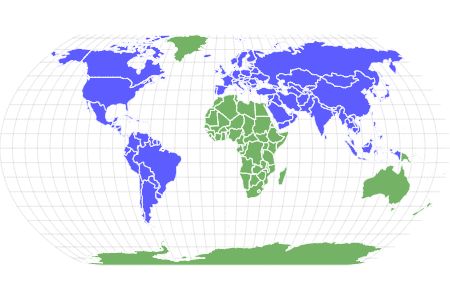Porcupine
Erethizon Dorsaum
There are 30 different species worldwide!
Advertisement
Porcupine Scientific Classification
- Kingdom
- Animalia
- Phylum
- Chordata
- Class
- Mammalia
- Order
- Rodentia
- Family
- Erethizontidae
- Genus
- Erethizon
- Scientific Name
- Erethizon Dorsaum
Read our Complete Guide to Classification of Animals.
Porcupine Conservation Status
Porcupine Facts
- Main Prey
- Roots, Leaves, Berries
- Habitat
- Dense forests and grassland
- Predators
- Owl, Eagles, Wolves
- Diet
- Omnivore
- Average Litter Size
- 1
View all of the Porcupine images!
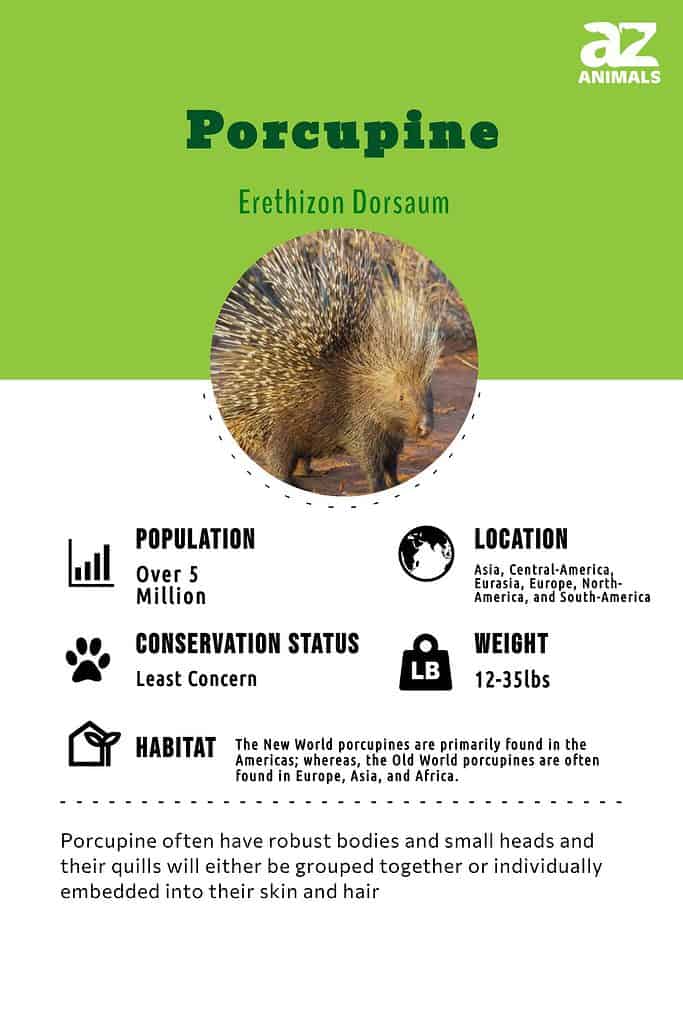
Porcupines are the third largest rodent on the planet. They are broken down into two types of porcupines, which are Old World and New World porcupines. These large rodents are known to fight off enormous predators, and they feast on plants, shrubs, and trees throughout the year. Despite their fierce-looking exterior, they are gentle and docile creatures unless provoked.
Porcupine Top Facts
- Quills have an antibiotic grease layer that helps to prevent infection in humans and animals.
- Porcupines have the ability to fight off even the largest and most dangerous of predators, including leopards.
- Baby porcupines are called porcupines, and a group of porcupines is called a prickle.
You can check out more incredible facts about porcupines.
Scientific Name
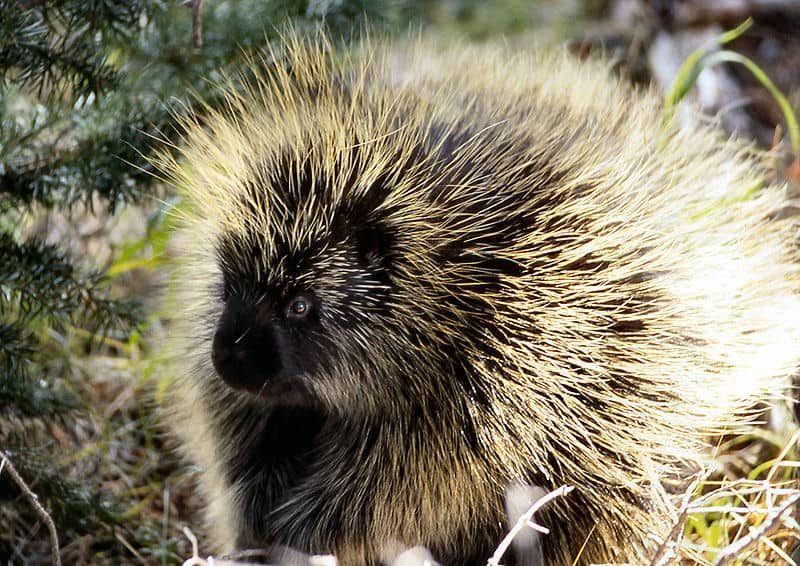
The taxonomy of Porcupines is broken down into the Rodentia order, the Erethizontidae (New World), or Hystricidae (Old World).
©National Park Service – Public Domain
The taxonomy of Porcupines is broken down into the Rodentia order, the Erethizontidae (New World) or Hystricidae (Old World) family, and the Erethizon or Chaetomys genus. The Hystricidae porcupines stay on the ground for the most part and live in Europe, Asia, and Africa.
Erethizontidae porcupines enjoy climbing trees and swimming throughout the Americas. The actual name of porcupine originates from the French word porcespin, which translates to quill pig. There are over two dozen species of porcupines across the world, including:
Family Hystricidae (Old World porcupines):
- Malayan porcupine
- Sunda porcupine
- Cape porcupine
- Crested porcupine
- Indian porcupine
- Thick-spined porcupine
- Philippine porcupine
- Sumatran porcupine
- African brush-tailed porcupine
- Asiatic brush-tailed porcupine
- Long-tailed porcupine
Family Erethizontidae (New World porcupines):
- Bristle-spined rat
- Baturite porcupine
- Bicolored-spined porcupine
- Streaked dwarf porcupine
- Bahia porcupine
- Black-tailed hairy dwarf porcupine
- Mexican hairy dwarf porcupine
- Black dwarf porcupine
- Brazilian porcupine
- Frosted hairy dwarf porcupine
- Andean porcupine
- Rothschild’s porcupine
- Roosmalen’s dwarf porcupine
- Stump-tailed porcupine
- Santa Marta porcupine
- Coandumirim
- Paraguayan hairy dwarf porcupine
- Brown hairy dwarf porcupine
- North American porcupine
Evolution and Origins
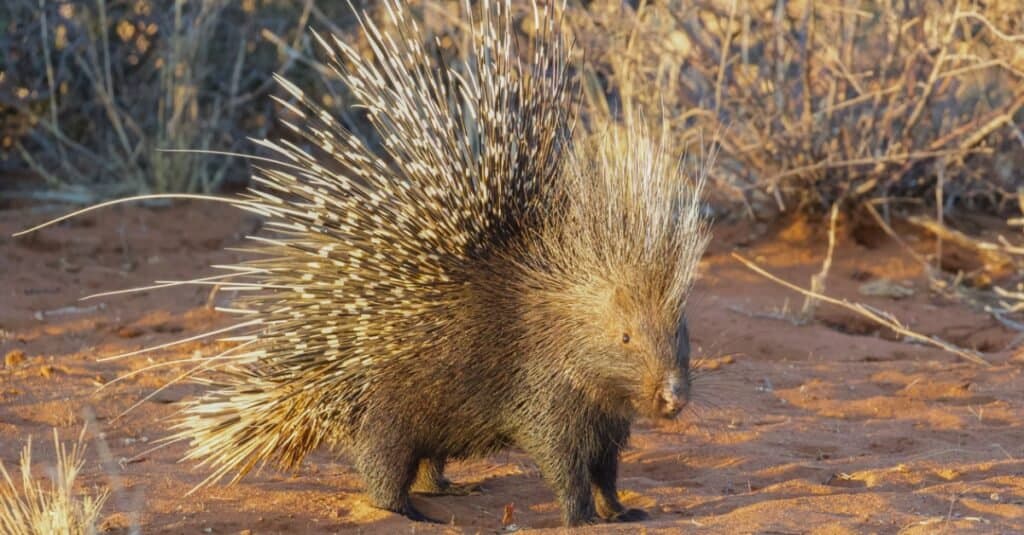
The quills of a porcupine can cause the death of a
lion
.
©iStock.com/Pedro Ferreira do Amaral
Porcupines are large, terrestrial rodents that are known for their sharp quills. They belong to the rodent family Erethizontidae and are native to North America, South America, and parts of Africa and Asia.
The earliest known porcupines date back to the Eocene epoch, around 55 million years ago. They evolved from a common ancestor shared with other rodent groups such as beavers and rats. Over time, they developed their distinctive quills as a defense mechanism against predators.
Porcupines are herbivores and have a varied diet, mostly eating tree bark, fruits, vegetables, and sometimes small animals. They are also known for gnawing on bones for their minerals.
Porcupines have a slow reproduction rate, and usually only have one litter per year, with one to three babies. They are also known for their longevity, some species can live up to 20 years in the wild.
Appearance & Behavior
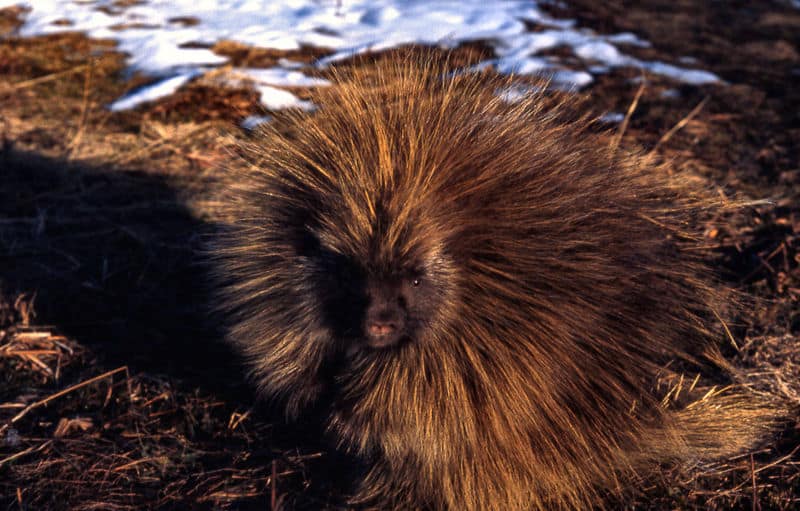
Each species of porcupine looks a bit different from the next.
©National Park Service – Public Domain
Each species of porcupine looks a bit different from the next. However, they do have some general appearance characteristics, such as they often have robust bodies and small heads. Their quills will either be grouped together or individually embedded into their skin and hair. These quills are their defense. They will drop their quills in the path of a potential predator to protect themselves
The front of their bodies is most vulnerable as it is covered with hair rather than quills. The base color of the hair can vary, including to be yellow, brown, grayish brown, dark brown, or black. The patterns that overlay the base layer can also vary in color, including black, orange, yellow, and white.
There are even albino porcupines in some parts of the world. Most porcupines range between 25 and 40 inches long, which includes their tail. They typically weigh between 10 and 40 pounds. Both males and females are roughly the same size. And many species have hairless soles that make them excellent climbers.
Porcupines are solitary animals that spend most of their time alone. They will gather in groups during the winter and spend time with a potential mate during courtship. A group of porcupines is called a prickle. When they do gather as a group during the winter, you will find a group of up to 12 porcupines sheltering together.
Habitat
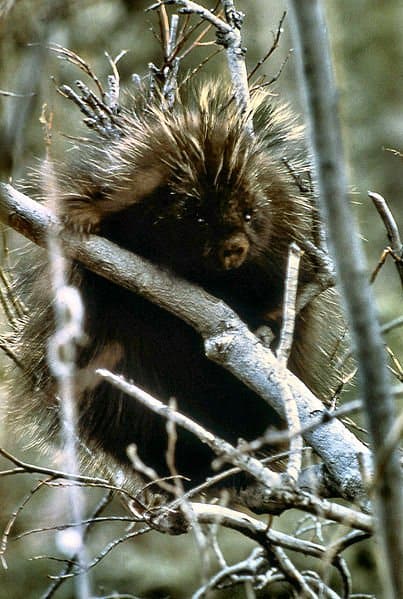
Where do porcupines live? The New World porcupines are primarily found in the Americas; whereas, the Old World porcupines are often found in Europe, Asia, and Africa. You will find porcupines in the Americas enjoy exploring the trees and water as much as land.
However, the porcupines in other parts of the world typically remain on solid land for the most part. You will find them living in nearly any type of terrain, including deserts, forests, grasslands, mountains, and rainforests.
They can adapt quite easily to their environments. Many porcupine species prefer to spend their downtime inside rocky crevices, caves, tangles of roots, brush, tree branches, burrows, and hollow logs and trees. Their home, wherever it may be, is called a den. They do not hibernate; however, they are nocturnal so they sleep during the day and explore at night.
Diet
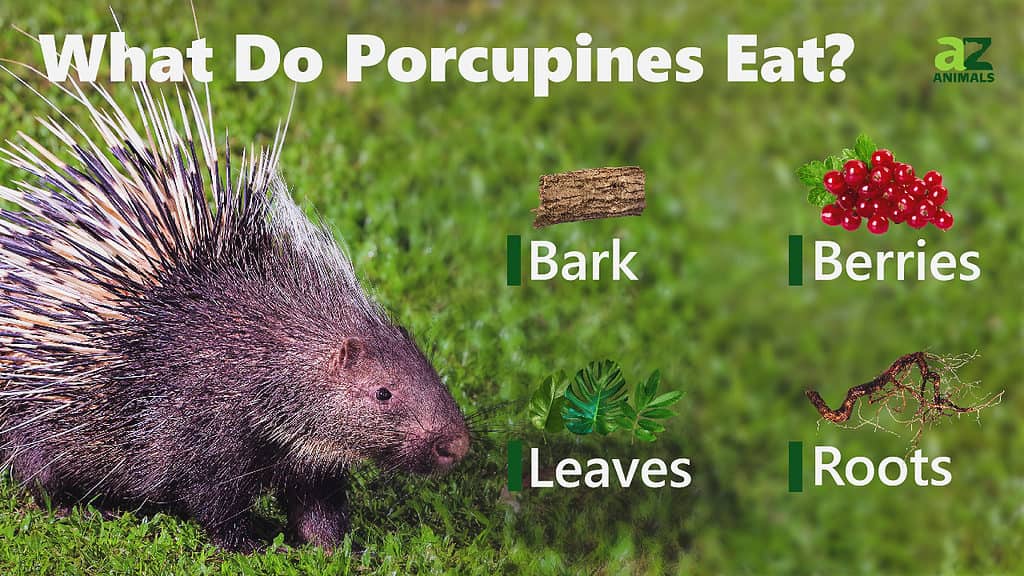
Porcupines the world over are herbivores. They eat roughly 0.9 pounds of food each day. During the winter, they rely upon tree bark as a primary source of nutrients. Due to harsh conditions, they often lose roughly 17% of their weight in the winter due to a lack of nitrogen in their winter diet. In Spring, porcupines prefer leaf blades rich in protein. If trees begin to develop toxic tannins, they will select more herbaceous plants and trees with fewer tannins.
Summertime brings about more dietary changes, including potassium-rich foliage. This can lead to excreting too much sodium which forces porcupines to go in search of salt. In nature, they may find salt in a variety of sources, such as aquatic plants.
When they do not find it in nature, they look for human-made sources, including tires, plywood, handles of tools, and brake lines. In some instances, they will eat certain nuts and fruit. Despite their dietary habits in nature, they cause far less damage than insects, disease, winds, and fires. For a complete analysis of their diet, give our ‘What Do Porcupines Eat?’ page a read!”
Predators and Threats
The small stature of a porcupine, particularly young porcupines, makes them vulnerable to a number of predators, including great horned owls, black bears, bobcats, martens, long-tailed weasels, ermines, coyotes, and mink. The fisher is their most common predator. Fishers can even prevent porcupine populations from growing.
If a predator does approach, the porcupine will turn its back to the predator keeping the quills facing the threat at all times. However, if the predator can get the porcupine on its back, it will often lose the battle. In some instances, porcupines have fought off an attack with their quills, including against highly dangerous animals like a leopard. When an approaching predator gets a quill embedded into their paw or body, they will often retreat as the quills are quite painful and difficult for animals to remove.
The Phillippine porcupine is the only porcupine categorized as vulnerable at this time. All others are listed in the least concern classification. The biggest threat to the global porcupine population is human deforestation, wildfires, and infrastructure development. These actions displace porcupines from their homes and force the slow-moving rodents to search for new sources of food and shelter. Cars are also considered a threat to porcupines as porcupines move too slowly when crossing the street.
Reproduction, Babies, and Lifespan
The mating ritual of porcupines includes only dominant male porcupines mating with several females, and less dominant males may not mate at all. Males will defend their mate for several days during the annual breeding season to fight off other potential suitors.
Females will also fight for their territory against other female porcupines. Male suitors are attracted to the scent and vocalizations of females. Mating will only occur once a female selects a male and becomes open to his advances.
The annual breeding season lasts from October to November. A female will carry for 210 days and give birth to one to three offspring. Baby porcupines are typically born in April or May, and they are called porcupines.
Newborns weigh between 0.88 to 1.17 pounds and are 10 inches long. Their hair is soft during birth. Quills will harden after a few hours. Their eyes often do not open for several days. The mother will nurse for a short time. After five months, the offspring will become entirely independent and left to survive their first winter on their own.
The average lifespan of a wild porcupine is five to seven years. Porcupines raised in captivity might live up to 10 years. The Prague Zoo is known to have had an Indian crested porcupine for at least 30 years. As porcupines age, they can suffer from disease and loss of senses that make them more vulnerable to predators and natural death.
Population
All but one porcupine species is considered a least concern at this time. As a result, population studies are not overly accessible making it difficult to determine the global population size of porcupines. The only known threats to population growth at this time are the fishing predator and human development.
View all 192 animals that start with PPorcupine FAQs (Frequently Asked Questions)
Are porcupines herbivores, omnivores, or carnivores?
Porcupines are strictly herbivores. They eat plants, twigs, foliage, leaves and more. The porcupine’s diet changes with the seasons.
Do porcupines Hibernate?
Porcupines do not hibernate. They do, however, burrow in trees, caves and small spaces near food sources with a group of other porcupines during winter. They are also nocturnal rodents that sleep during the day and feed during the night.
Do Porcupines shoot their quills?
Porcupines cannot shoot quills. They can easily detach to drop them in the path of a predator. Once a predator has a quill stuck, they are likely to retreat. This allows porcupines to fight off some of the most dangerous predators on the planet.
Where do porcupines live?
Porcupines can inhabit nearly any type of environment, including forests, grasslands, shrubbery, rainforests and deserts.
How many quills do porcupines have?
Most porcupines have roughly 30,000 quills. Any quills that are lost will typically regrow.
Can a porcupine kill a human?
It is unlikely. Quills are covered in an antibacterial coating that feels greasy to the touch. This reduces the chance of infection developing if you are stuck by a quill.
What Kingdom do Porcupines belong to?
Porcupines belong to the Kingdom Animalia.
What phylum do Porcupines belong to?
Porcupines belong to the phylum Chordata.
What class do Porcupines belong to?
Porcupines belong to the class Mammalia.
What family do Porcupines belong to?
Porcupines belong to the family Erethizontidae.
What order do Porcupines belong to?
Porcupines belong to the order Rodentia.
What genus do Porcupines belong to?
Porcupines belong to the genus Erethizon.
What type of covering do Porcupines have?
Porcupines are covered in Spikes.
What do Porcupines eat?
Porcupines eat roots, leaves, and berries.
What are some predators of Porcupines?
Predators of Porcupines include owls, eagles, and wolves.
What is the average litter size for a Porcupine?
The average litter size for a Porcupine is 1.
What is an interesting fact about Porcupines?
There are 30 different Porcupine species worldwide!
What is the lifespan of a Porcupine?
Porcupines can live for 8 to 12 years.
Who would win a fight: Porcupine vs Lion?
A lion would win a fight against a porcupine.
The lion is an ambush predator, and it’s fast enough that it could take a porcupine by surprise in the right situation, flipping it over and clawing or biting it to death.
Who would win a fight: Dogs Vs Porcupines?
A porcupine would win a fight against a dog, but this would be a close one.
If we have a situation where the dog is the aggressor, and the porcupine is attacked, the dog gets too many quills in it to continue its assault. The dog is forced to leave the porcupine alone because it’s in so much pain or has too many quills to bite effectively. In this case, the porcupine wins.
What's the difference between a porcupine and an echidna?
Porcupines live in very different locations from the Australian-dwelling echidna. Additionally, the spines of the echidna are very different from porcupine quills.
Thank you for reading! Have some feedback for us? Contact the AZ Animals editorial team.
Sources
- David Burnie, Dorling Kindersley (2011) Animal, The Definitive Visual Guide To The World's Wildlife
- Tom Jackson, Lorenz Books (2007) The World Encyclopedia Of Animals
- David Burnie, Kingfisher (2011) The Kingfisher Animal Encyclopedia
- Richard Mackay, University of California Press (2009) The Atlas Of Endangered Species
- David Burnie, Dorling Kindersley (2008) Illustrated Encyclopedia Of Animals
- Dorling Kindersley (2006) Dorling Kindersley Encyclopedia Of Animals
- David W. Macdonald, Oxford University Press (2010) The Encyclopedia Of Mammals

